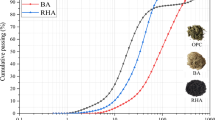Abstract
Loose sand particles could be cemented to sandstone by bio-cement (microbial induced magnesium carbonate). The bio-sandstone was firstly prepared, and then the compressive strength and the porosity of the sandstone cemented by microbial induced magnesium carbonate were tested to characterize the cementation effectiveness. In addition, the formed mineral composition and the microstructure of bio-sandstone were analyzed by X-ray diffraction (XRD) and scanning electron microscopy (SEM), respectively. The experimental results show that the feasibility of binding loose sand particles using microbial induced magnesium carbonate precipitation is available and the acquired compressive strength of bio-sandstone can be excellent at certain ages. Moreover, the compressive strength and the porosity could be improved with the increase of microbial induced magnesium carbonate content. XRD results indicate that the morphology of magnesium carbonate induced by microbe appears as needles and SEM results show that the cementation of loose sand particles to sandstone mainly relies on the microbial induced formation of magnesium carbonate precipitation around individual particles and at particle-particle contacts.
Similar content being viewed by others
References
Whiffin VS, Van Paassen LA, Harkes MP. Microbial Carbonate Precipitation as a Soil Improvement Technique[J]. Geomicrobiology Journal, 2007, 24: 417–423
Rong H, Qian CX, Li LZ. Influence of Molding Process on Mechanical Properties Sandstone Cemented by Microbe Cement [J]. Construction and Building Materials, 2012, 28: 238–243
Le Metayer-Levrel G, Castanier S, Orial G, et al. Applications of Bacterial Carbonatogenesis to the Protection and Regeneration of Limestone in Buildings and Historic Patrimony [J]. Sedimentary Geology, 1999, 126: 25–34
Nemati M, Voordouw G. Modification of Porous Media Permeability, Using Calcium Carbonate Produced Enzymatically in situ [J]. Enzyme and Microbial Technology, 2003, 33: 635–642
DeJong JT, Fritzges MB, Nusslein K. Microbially Induced Cementation to Control Sand Response to Undrained Shear [J]. Journal of Geotechnical Geoenvironmental Engineering, 2006, 132: 1 381–1 392
DeJong JT, Brina MM, Brian CM, et al. Bio-mediated soil improvement [J]. Ecological Engineering, 2010, 36: 197–210
Whiffin VS. Microbial CaCO 3 Precipitation for the Production of Biocement [D]. Western Australia: Murdoch University, 2004
Ivanov V, Chu J. Applications of Microorganisms to Geotechnical Engineering for Bioclogging and Biocementation of Soil in situ [J]. Reviews in Environmental Science and Biotechnology, 2008, 7: 139–153
Muynck DW, Belie DN, Verstraete W. Microbial Carbonate Precipitation in Construction Materials: A review [J]. Ecological Engineering, 2010, 36: 118–136
Muynck DW, Verbeken K, Belie DN, et al. Influence of Urea and Calcium Dosage on the Effectiveness of Bacterially Induced Carbonate Precipitation on Limestone [J]. Ecological Engineering, 2010, 36: 99–111
Muynck DW, Debrouwer D, Belie DN, et al. Bacterial Carbonate Precipitation Improves the Durability of Cementitious Materials [J]. Cement and Concrete Research, 2008, 38:1 005–1 014
Qian CX, Wang JY, Wang RX, et al. Corrosion Protection of Cement-Based Building Materials by Surface Deposition of CaCO3 by Bacillus pasteurii[J]. Materials Science and Engineering C, 2009, 29: 1 273–1 280
Ramachandran SK, Ramakrishnan V, Bang SS. Remediation of Concrete Using Micro-organisms [J]. ACI Materials Journal, 2001, 1: 3–9
Belie DN. Microorganisms versus Stony Materials: A Love-hate Relationship [J]. Materials and Structures, 2010, 43: 1191–1202
Welton RG, Ribas SM, Gaylarde C, et al. Techniques Applied to the Study of Microbial Impact on Buliding Materials [J]. Materials and Structures, 2005, 38: 883–893
Bachmeier KL, Williams AE, Warmington JR, et al. Urease Activity in Microbiologically-induced Calcite Precipitation [J]. Journal of Biotechnology, 2002, 93: 171–181
Ferris FG, Stechmeier LG, Kantzas A, et al. Bacteriogenic Mineral Plugging [J]. Journal of Canadian Petroleum Technology, 1996, 35(8): 56–61
Ramakrishnan V, Ramesh KP, Bang SS. Bacterial Concrete [J]. Proc. of SPIE-Int Society of Optical Engineering, 2001, 4234: 168–176
Author information
Authors and Affiliations
Corresponding author
Additional information
Funded by the National Natural Science Foundation of China (No. 51072035), the Ph D Program’s Foundation of Ministry of Education of China (No. 20090092110029), the Research Innovation Program for College Graduates of Jiangsu Province (No. CXZZ_0145), the Scientific Research Foundation of Graduate School of Southeast University (Nos. YBJJ1127 and YBPY1208) and the Ph D Program’s Foundation Funded by the Science and Technology Review (kjdb2011001)
Rights and permissions
About this article
Cite this article
Rong, H., Qian, C. Cementation of loose sand particles based on bio-cement. J. Wuhan Univ. Technol.-Mat. Sci. Edit. 29, 1208–1212 (2014). https://doi.org/10.1007/s11595-014-1069-2
Received:
Accepted:
Published:
Issue Date:
DOI: https://doi.org/10.1007/s11595-014-1069-2




